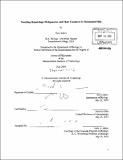Modeling hematologic malignancies and their treatment in humanized mice
Author(s)
Leskov, Ilya, Ph. D. Massachusetts Institute of Technology
DownloadFull printable version (20.85Mb)
Other Contributors
Massachusetts Institute of Technology. Dept. of Biology.
Advisor
Jianzhu Chen.
Terms of use
Metadata
Show full item recordAbstract
Approximately 10% of all cancer deaths in the United States are due to neoplasms of the hematopoietic system, such as leukemias and lymphomas. Genetically engineered mouse models of these diseases have yielded invaluable insights into the ways normal processes become corrupted, leading to cancer development, progression, and spreading. Yet, as our understanding of cancer in mice grows more sophisticated, it is important to be aware of vital differences between murine models and human patients, differences in basic physiology, immunology, and in susceptibility to cancer itself. Furthermore, as anti-neoplastic therapy becomes increasingly focused on human-specific therapies, mouse models become less useful in screening and evaluating potential new therapies. Humanized mice - immunodeficient animals engrafted with human hematopoietic stem cells (HSCs) that subsequently give rise to various mature blood lineage cells - are an elegant solution to these problems, as they offer an ethical and practical way to study human cell biology in vivo. Recent advances in human HSC culture and expansion make it possible not only to generate large cohorts of humanized mice, but also to modify HSCs genetically prior to their engraftment. Such transgenesis of adult human stem cells permits modeling of hematologic malignancies in human cells. To that end, a lentiviral vector capable of stoichiometric expression of up to three transgenes in a B cell-specific manner was constructed; in this case, these transgenes included the GFP reporter and the clinically-important oncogenes Bcl-2 and Myc. Enforced overexpression of Bcl-2 resulted in a benign B cell hyperplasia, but overexpression of Bcl-2 in combination with Myc led to a rapid development of an aggressive disease that recapitulated the histopathological and clinical aspects of human progenitor B cell acute lymphoblastic leukemia (pro-B ALL). Leukemic cells that arise in these mice expressed CD52 and were transplantable into secondary recipients; these were subsequently used to test the efficacy of a human specific monoclonal antibody to CD52, alemtuzumab, which is currently approved for treatment of chronic lymphocytic leukemia, but not ALL. Alemtuzumab treatment of secondary mice resulted in an almost complete clearance of leukemic blasts from the periphery and a significant improvement in life expectancy, and antibody-dependent tumor cell killing was shown to be mediated by macrophages. The lack of alemtuzumab activity in the brain and bone marrow of the mice was investigated, and overcome by combining alemtuzumab with the commonly used chemotherapeutic agent cyclophosphamide. Great synergy between alemtuzumab and cyclophosphamide seen in this model suggests that a further investigation into this clinically relevant drug combination is well warranted.
Description
Thesis (Ph. D.)--Massachusetts Institute of Technology, Dept. of Biology, 2010. Cataloged from PDF version of thesis. Includes bibliographical references.
Date issued
2010Department
Massachusetts Institute of Technology. Department of BiologyPublisher
Massachusetts Institute of Technology
Keywords
Biology.